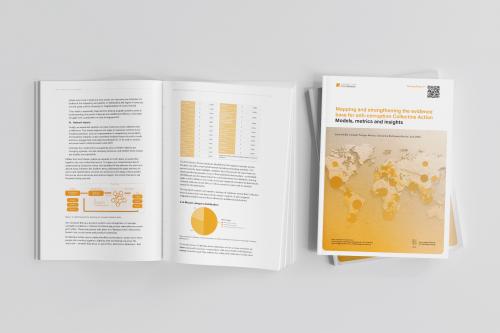How informal power networks can instrumentalise anti-corruption institutions

In many countries with high levels of corruption, there is also a strong demand for government to do something about it. With the right conditions, that can fuel solid political commitments. We’ve seen, however, that even in cases where governments do all the right things on paper – strengthen legal frameworks, establish dedicated anti-corruption agencies, etc. – there's a gap between what they promise and what happens in practice.
In a chapter for the forthcoming Routledge Handbook of Anti-Corruption Research and Practice, we go deeper into exploring one reason for this gap, namely the political instrumentalisation of efforts to prevent and curb corruption. We explain why and how it happens and provide examples from countries across the globe. This article presents the key findings.
Why? Informal governance and corruption
If you want to understand why and how anti-corruption institutions and laws can be used and abused to achieve strategic goals, you have to understand how informal networks of elites function and how this relates to corruption.
High levels of corruption are often associated with informal governance practices. Informal governance is established through powerful networks that connect political elites, business interests and ordinary citizens. These informal networks can have different objectives. They help:
- political elites win and stay in power;
- business interests to access profitable benefits such as government contracts; and
- citizens cope and gain access to public services where governance is weak and resources are scarce.
When informal networks rule, decisions, including on allocating public resources, are made for personal gain. Resources are redistributed informally for the benefit of insiders and at the expense of those outside these networks. Power is used to protect and ensure impunity for the loyal. Informal governance practices become entrenched and persist independently of individual network members. The result is a vicious cycle of informal governance and corruption that undermines the effectiveness of formal institutions.
Informal governance practices are particularly evident in contexts characterised by state capture, defined as “a type of systematic corruption whereby narrow interest groups take control of the institutions and processes through which public policy is made, directing public policy away from the public interest and instead shaping it to serve their own interests”.
Instrumentalisation as a way out of the dilemma
Political power networks that face pressure to do something to curb corruption find themselves in a dilemma. They need to respond to demands for anti-corruption, but corruption is functional to the network's very survival.
To prevent negative consequences and sanctions for the informal political power network itself, those pulling the strings need to ensure that anti-corruption institutions and their efforts are not too effective. They must be reined in, for example by instrumentalising anti-corruption endeavours.
Here, political instrumentalisation means that dedicated anti-corruption agencies, or other public institutions charged with preventing and combating corruption or ensuring transparency and accountability, are informally repurposed to benefit those within the network. The result is that formal governance is weakened and the basic principles of the rule of law erode.
The purpose can be two-fold (not mutually exclusive):
- To undermine the anti-corruption institution's formal powers and weaken its impact on the power network.
- To shape the institution’s operations in a way that favours and strengthens the power network.
Three strategies: co-optation, control and camouflage
Based on research on informal governance and corruption combined with insights on mechanisms of state capture, we can identify three general strategies informal power networks use to shape anti-corruption institutions or undermine their formal powers:
- Co-optation: aligning institutional incentives with that of the power network
This can be achieved by appointing allies and building informal loyalties both between the anti-corruption institution and the power network, and with other stakeholders in the law enforcement system i.e. the prosecution or judiciary. - Control: weakening the influence of the institution in relation to the power network
This is possible by limiting the resources or mandate of the anti-corruption institution, and by limiting the space for anti-corruption accountability stakeholders such as the media and civil society.
Power networks shape the institution’s operations in a manner favourable to maintaining the network through:
- Camouflage: formal rules create the façade of commitment to anti-corruption...but they work to protect the network, because:
- they do not apply to corrupt network insiders (impunity);
- they are selectively applied to corrupt outsiders or to discipline network dissenters (weaponisation or “rule by law”).
Overarching insights and reflections
Hard to “see”
Given that political instrumentalisation of anti-corruption is enacted through formal structures and processes, it can be hard to observe. It can also look different on the surface. Control can happen through restrictions that weaken institutions. But it can also work through the provision of more resources, for example to institutions that have been co-opted to protect network insiders.
A web of formal and informal rules
Anti-corruption actions can be ambivalent when formal rules are selectively applied to camouflage corrupt informal practices. Formal and informal interests and rules are at play simultaneously, with different narratives being offered to insiders and outsiders. A successful corruption prosecution can give the appearance of a commitment to fighting corruption while in reality serving to target individuals outside the power network.
Rule of law or rule by law?
With high levels of informality, it’s difficult to tell if anti-corruption outcomes reflect genuine efforts to enforce the law equally and predictably (rule of law), or if they indicate a strategic use of formal rules for the benefit of the informal network (rule by law). Does a low number of high-profile corruption cases mean that control of corruption is strong, that investigation and prosecution capacities are weak, or that someone is being protected?
Any bright sides?
The book chapter concludes by providing practical entry points on what can be done, even in challenging contexts, to strengthen anti-corruption efforts.
Three entry points are worth exploring:
- Let’s keep in mind: Power networks are fluid and can change. When their incentives align with the anti-corruption objectives of promoting integrity and curbing corruption, informal governance practices can also have a positive impact. It’s important to look for changes in the power structure to seize windows of opportunity.
- Ambivalence in institutional decision-making can be reduced by pushing for transparent, standard operating procedures for anti-corruption institutions.
- Even if formal political commitments to anti-corruption seem more rhetorical than genuine, they can still provide a useful anchor to promote and drive efforts for real change. Research shows that when governments fail to deliver on their commitments, they come under pressure to explain why change has not happened. This keeps anti-corruption high on the political agenda and in societal discourse.
A starting point is to gain a thorough understanding of the broader political and governance context. In this regard, we have developed a framework for assessing and monitoring contextual factors that impact the performance of anti-corruption institutions. It allows us to better interpret anti-corruption actions, identify emerging positive or negative trends and respond more effectively to risks and opportunities.
Learn more
- Saba Kassa’s chapter “Insights on the Political Instrumentalisation of Anti-Corruption Institutions: In Between a Rock and a Hard Place?” will be published in The Routledge Handbook of Anti-Corruption Research and Practice, available for pre-order on the publisher’s website.
- Kassa, Saba. 2024. “Navigating the political context: Practice insights and adaptive strategies to strengthen the anti-corruption and asset recovery justice chain”, Working Paper 52, Basel Institute on Governance.
- Baez-Camargo, Claudia and Alena Ledeneva. 2017. “Where Does Informality Stop and Corruption Begin? Informal Governance and the Public/Private Crossover in Mexico, Russia and Tanzania.” Slavonic and East European Review 95, no. 1: 49-75.
- Baez-Camargo, Claudia and Lucy Koechlin. 2018. “Informal Governance: Comparative Perspectives on Co-optation, Control and Camouflage in Rwanda, Tanzania and Uganda.” International Development Policy Journal, 78-100.
- Basel Institute on Governance. 2023. “Informal Governance.”
- Dávid-Barrett, Elizabeth. 2023. “State capture and development: a conceptual framework.” Journal of International Relations and Development 26, 224-244.




